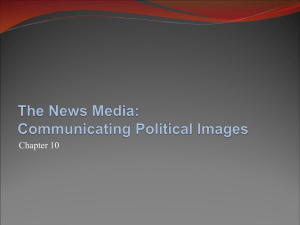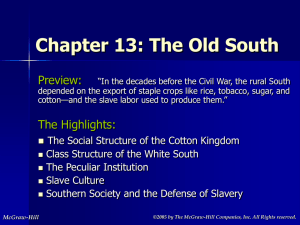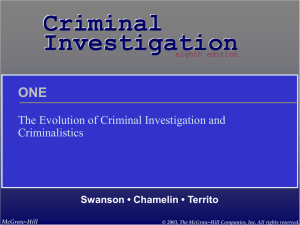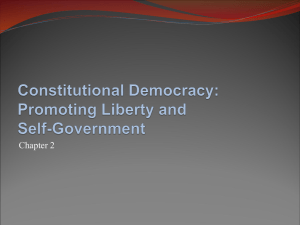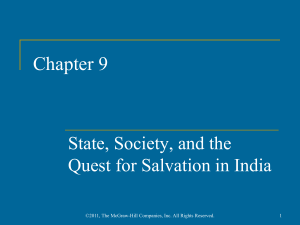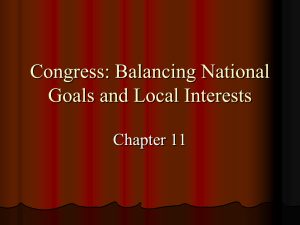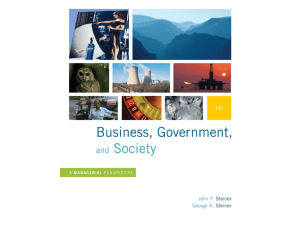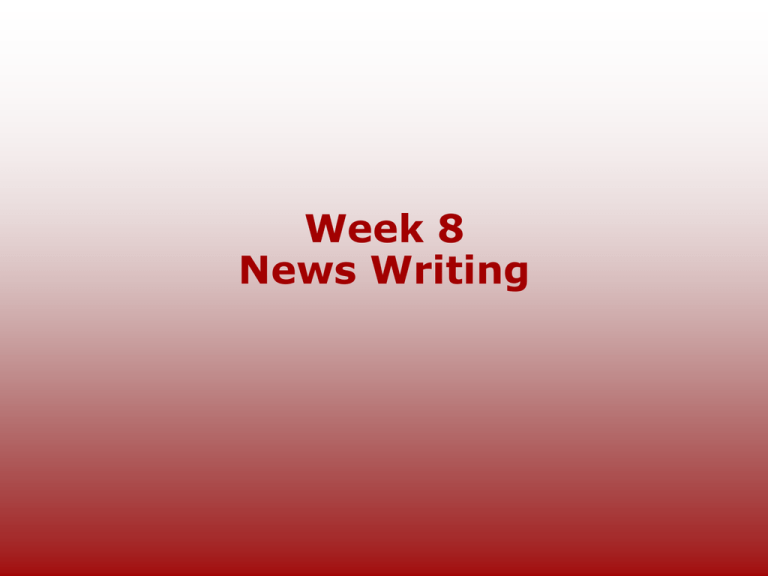
Week 8
News Writing
News Quiz #4
English name, class number (1 or 2)
and student number
In the form of leads with the 6W’s in
the correct order
5 news stories from the past week
International
Beat
China
Xi’an
XISU
lcome to the world of
Every culture seeks effective constantly evolving,
dramatically. The typi
urnalism, where
ways to spread new
reflecting and shaping its
newspaper of 1800 wa
porters have been
information and gossip. In
culture.
undisciplined mishma
gging dirt, raking muck, ancient times, news was
Others see it as an
legislative proceeding
king headlines and
written on clay tablets. In
inspiring quest for free
long-winded essays a
adlines for centuries
Caesar’s age, Romans read
speech, an endless power
secondhand gossip. B
w. It’s a history full of
newsletters compiled by
struggle between Authority 1900, a new breed of
bloid trash, of slimy
correspondents and
(trying to control information)tor had emerged. Jour
nsationalists, of runkards, handwritten by slaves.
and the People (trying to
had become big busin
deadbeats and mmers” (asWandering minstrels spread learn the truth). Which brings Reporting was becom
a Harvard iversity
news (and the plague) in the to mind the words of A.J.
disciplined craft. And
president once scribed
Middle Ages. Them came ink Liefling: “Freedom of the
newspapers were bec
Tim Harrower
reporters).
on paper. Voices on airwaves. press is guaranteed only to more entertaining and
But it’s a history full of Newsreels, Web sites, And
htose who own one.”
essential than ever, w
roes, too: men and
24-hour cable news networks. In the pages ahead, we’ll most of the features w ex
men risking their lives
Thus when scholars
take a quick tour of 600 years today: Snappy headlines,
tell stories of war and
analyze the rich history of
of journalism history, from Comic Sports pages. And
agedy, risking prisonment journalism, some view it in hieroglyphics to hypertext: “inverted pyramid” sty
to defend
terms of technological
the media, the message and writing that made stori tig
ee speech. And as you
progress—for example, the the politics.
and newsier.
n see here, reports have dramatic impact of bigger,
Technical advances and
Radio and television
come beloved characters faster printing presses.
brilliant ideas forged a new brought an end to
p culture, too, turning up
Others see journalism as a style of journalism. It was a newspapers’ media mono
movies, comics and TV specialized form literary
century of change, and
Why? Well yourself: Wh
ows as if guided by an
expression, one that’s
newspapers changed
did yo
cult McGraw-Hill
hand.
© 2010 The McGraw-Hill Companies, Inc. All rights reserved.
Inside Reporting
5
Covering the news
Slide
Covering the news
Covering a beat
Writing
obituaries
Covering accidents
and disasters
Covering fires
Covering crime
McGraw-Hill
© 2010 The McGraw-Hill Companies, Inc. All rights reserved.
Slide
Covering a beat
Beat reporters focus on
specific topics or institutions
New beat
• Do research.
• Meet people.
McGraw-Hill
Make lists
•Key sources
•Upcoming meetings and
events
•Story ideas
© 2010 The McGraw-Hill Companies, Inc. All rights reserved.
Slide
Covering accidents and
disasters
Most editors maintain standards
What is the severity?
How many people
are affected?
Is it local?
McGraw-Hill
© 2010 The McGraw-Hill Companies, Inc. All rights reserved.
Slide
Covering accidents and
disasters
Writing stories on traffic accidents
Usually lead with WHAT or WHO.
Start with a delayed-identification
lead.
• Delay naming victims until 2nd
or 3rd paragraph.
• Distribute key facts logically
through first few paragraphs.
• Generally no need to identify
police by name.
McGraw-Hill
© 2010 The McGraw-Hill Companies, Inc. All rights reserved.
Slide
Covering accidents and
disasters
Traffic accident checklist
Victims
Extent of
injuries/cause of
death
Cause of accident
according to police
Location
McGraw-Hill
Time
Vehicles
Arrests or citations
Comments
Acts of heroism
Relevant facts
© 2010 The McGraw-Hill Companies, Inc. All rights reserved.
Slide
Covering accidents and
disasters
When disaster strikes
Arriving on the scene
• Go where the
action is.
• Question
authorities.
• Talk to victims and
eyewitnesses.
McGraw-Hill
• Record details that
capture the scene.
• Check in often with
your editors.
• Collaborate.
© 2010 The McGraw-Hill Companies, Inc. All rights reserved.
Slide
Covering accidents and
disasters
When disaster strikes
Dealing with victims of a tragedy
• Ask permission.
• Go slow.
• Empathize—but
watch what you
say.
McGraw-Hill
© 2010 The McGraw-Hill Companies, Inc. All rights reserved.
Slide
Covering fires
Fire story checklist
Victim names
Extent of
injuries/cause of
death
Type of building
Location
Time
McGraw-Hill
How the fire was
discovered
Cause of fire
Number of fire
fighters
Estimated cost of
damage
© 2010 The McGraw-Hill Companies, Inc. All rights reserved.
Slide
Covering fires
Fire story checklist…
Extent of
insurance
coverage
Acts of heroism
Weather
Effect of fire on
evacuees
McGraw-Hill
Plans to relocate
victims or rebuild
structures
Arrests or citations
Anecdotes and
descriptions
Any other unusual
aspects
© 2010 The McGraw-Hill Companies, Inc. All rights reserved.
Slide
Covering fires
Organizing stories on fire
Death or injury usually
the lead.
Focus on the most
compelling aspect.
Cover the aftermath.
May offer opportunity to
use narrative storytelling.
McGraw-Hill
© 2010 The McGraw-Hill Companies, Inc. All rights reserved.
Slide
Covering crime
Crime writing style and structure
Add color, not clutter.
Avoid sloppy allegations.
Explore chronological
story forms.
Inverted-pyramid lead
Chronology
Kicker
McGraw-Hill
© 2010 The McGraw-Hill Companies, Inc. All rights reserved.
Slide
Covering crime
What you should withhold
Names of minors
Names of victims
of sensitive
crimes
Names of
endangered
victims
Labeling people
as suspects
Stereotypes
McGraw-Hill
© 2010 The McGraw-Hill Companies, Inc. All rights reserved.
Slide
Covering crime
Homicide or assault story checklist
Victim’s name
Extent of
injuries/cause of
death
Location
Time
Circumstances
McGraw-Hill
Description of suspect
Name and
identification of
anyone arrested
Comments
Unusual factors
© 2010 The McGraw-Hill Companies, Inc. All rights reserved.
Slide
Covering crime
Theft story checklist
Type, value of items Description of
taken
suspect
Victim
Name and
identification of
Location
anyone arrested
Time
Comments
Circumstances
Unusual factors
McGraw-Hill
© 2010 The McGraw-Hill Companies, Inc. All rights reserved.
Slide
Covering speeches
Speeches: Before, during and after
Before
During
• Research the speaker. • Get a good seat.
• Request an advance
• Estimate the size of
copy of speech.
the audience.
• Ask if picture- taking • Monitor the mood of
will be allowed.
the crowd.
• Take along a tape
recorder.
McGraw-Hill
© 2010 The McGraw-Hill Companies, Inc. All rights reserved.
Slide
Covering speeches
Speeches: Before, during and after
After
• Create a compelling
lead.
• Avoid topic leads.
• Include minimal
background/
biographical data.
McGraw-Hill
• Highlight speaker’s
key points.
• Convey tone of
speech.
• Beware of false or
libelous comments.
© 2010 The McGraw-Hill Companies, Inc. All rights reserved.
Slide
Covering speeches
Speech story checklist
Speaker’s name
Description of
audience
Relevant credentials
Quotes
Reason for speech
Comments
Time, day and
location
Responses
Speaker’s fee
McGraw-Hill
© 2010 The McGraw-Hill Companies, Inc. All rights reserved.
Slide
Covering meetings
Explain issues, how decisions are
made, and what it means
Start with research. Go early.
Clarify. Condense. Dress
Concentrate.
appropriately.
Encourage readers
to attend meetings.
McGraw-Hill
© 2010 The McGraw-Hill Companies, Inc. All rights reserved.
Slide
Covering meetings
Explain issues, how decisions are
made, and what it means
Stick around after
the meeting.
McGraw-Hill
Remember, meetings
are not always news.
© 2010 The McGraw-Hill Companies, Inc. All rights reserved.
Slide
Covering meetings
Meeting story checklist
Group/agency name Crowd size
Location and length
of meeting
Atmosphere
Important decisions
Unusual events
Quotes
Reactions
McGraw-Hill
Graphics
What happens
next?
© 2010 The McGraw-Hill Companies, Inc. All rights reserved.
Slide
Covering meetings
Personalizing meetings
Write about real
people.
Write about real
issues.
McGraw-Hill
© 2010 The McGraw-Hill Companies, Inc. All rights reserved.
Slide
Covering sports
Three most common story types
Game stories
Feature stories
• Analysis
• Profiles
Columns
McGraw-Hill
© 2010 The McGraw-Hill Companies, Inc. All rights reserved.
Slide
Covering sports
Game story checklist
Final score
Key statistics
Teams’ names
Injuries
When and where
Both teams’ records
Key players and key
plays
What the game
means
Quotes
Other relevant
factors
Strategies
McGraw-Hill
© 2010 The McGraw-Hill Companies, Inc. All rights reserved.
Slide
Covering sports
Advance sporting event checklist
Significance of
game
Strategies
History
Other factors
Injuries
Key players
Records and recent
performances
Quotes
McGraw-Hill
Who’s favored
Time, place and
ticket information
© 2010 The McGraw-Hill Companies, Inc. All rights reserved.
Slide
Covering sports
Compiling, crunching sport stats
Conduct solid research.
Take careful notes.
Use stats selectively.
Add charts, graphs or
sidebars, if needed.
McGraw-Hill
© 2010 The McGraw-Hill Companies, Inc. All rights reserved.
Slide
Covering sports
Sports style
Team name usually
plural.
Use figures for
High school
measurements.
athletes are girls Use numerals for scores
and boys.
and time.
Abbreviate league
names.
McGraw-Hill
© 2010 The McGraw-Hill Companies, Inc. All rights reserved.
Slide
Covering sports
Tips for the sports beat
Covering events Writing stories
• Know the sport.
•
• Cultivate your sources.
•
• Ask tough, pointed
questions.
•
McGraw-Hill
Think plot, not play-byplay.
Avoid jargon and clichés.
Remember, it’s a game.
© 2010 The McGraw-Hill Companies, Inc. All rights reserved.
Ch. 3 eWorkbook exercises
https://highered.mcgrawhill.com/sites/0073378917/student_view0/
chapter3/exercise_3-4_3.html
3.3
POOR
Hayward is recovering from an earthquake that rocked the Bay
Area at 8:12 a.m. PDT on Monday morning.
Felt from Los Angeles to Redding, the quake appeared centered on a building housing McHenry’s Auto Supply at
2342 Plum St. That building partially collapsed, killing two workers and injuring six others, according to Jennifer
Vu, a public information officer from the Hayward Fire Department.
The quake appears to have been centered on the Hayward Fault, according to Penny Gertz, a scientist from the U.S.
Geological Survey in Menlo Park. The epicenter of the quake, which had a magnitude of 6.4 on the Richter scale,
was under the Hayward Hills, Gertz said.
Three of the six injured at McHenry’s were hurt seriously enough to require hospitalization at Hayward General
Hospital, Vu stated, adding that no other serious injuries have been reported in Hayward.
Twenty-one fire personnel, 12 police, and five American Red Cross workers responded to the incident, with some
arriving at the scene within four minutes of the collapse, Vu said.
Hayward resident Mike Beamer, whose apartment is across the street from McHenry’s, said he felt a rolling motion
that lasted for about 30 seconds, with a big jolt coming in the middle.
Hayward firefighters used ropes to stabilize the auto supply shop, conducted a search of the building and capped a gas
line after detecting a leak at the site.
People as far south as Los Angeles and as far north as Redding felt the quake, according to Gertz.
The lead fails to mention the most newsworthy immediate effects of the quake — death, injury and destruction —
instead giving us the bland “Hayward is recovering” and the trivial “8:12 a.m. PDT.”
The second sentence, which mentions McHenry’s, inaccurately suggests that the quake was “centered” on the
building, and still we don’t have any details about what happened there.
When we finally get to the deaths, the story possibly misidentifies the dead as “workers” when Vu only identifies them
as “people.” They could have been customers or even passersby.
From this point on, the details come randomly, with little sense of development or ranking by importance. The
3.3
GOOD
A powerful earthquake struck the San Francisco Bay Area on
Monday morning, partially collapsing an auto parts store,
killing at least two people and injuring six others.
The 8:12 a.m. temblor — felt from Redding to Los Angeles — measured 6.4 on the Richter scale and was centered on the
Hayward Fault under the Hayward Hills, according to Penny Gertz, a scientist from the U.S. Geological Survey in
Menlo Park.
The shaking triggered the partial collapse of McHenry’s Auto Supply at 2342 Plum St., killing two people and injuring six
others, according to Jennifer Vu, a public information officer from the Hayward Fire Department. Names of the dead
are being withheld pending notification of families, Vu said.
Three of those six were hurt seriously enough to require hospitalization and were transported to Hayward General Hospital,
according to Vu. She added that no other serious injuries have been reported in Hayward.
Mike Beamer, whose apartment is across the street from McHenry’s, said he felt a rolling motion that lasted for about 30
seconds, with a big jolt coming in the middle. “I was eating my breakfast and the room started rolling. I dove under
the table just as I heard an explosion outside and a chunk of cement flew through my kitchen window. That’s when
the screaming started across the street.”
Twenty-one fire personnel, 12 police and five American Red Cross workers responded to the incident, with some arriving
at the scene within four minutes of the collapse, Vu said.
Hayward firefighters used ropes to stabilize the auto supply shop, conducted a search of the building and capped a gas line
after detecting a gas leak at the site.
Much stronger. Notice that the death, injuries and building collapse are in the lead, followed by details suggesting the
magnitude of the quake in the second paragraph. From there the story moves into a more detailed look at McHenry’s,
the main site of destruction, fleshing out the details on the most significant elements of the story, always organized
4.1
1. Passive
Active voice rewrite: Police arrested him as he climbed into the mansion’s
window.
2. Passive
Active voice rewrite: Understudy Jenny Baker will replace retiring treasurer
Bill Habib.
3. Active
4. Passive
Active voice rewrite: The employees see the manager as benevolent but
demanding.
5. Passive
Active voice rewrite: How she said it angered me more than what she said.
4.3
1.
2.
3.
4.
This year’s $20 to $25 tickets were $5 more expensive than last year’s.
She must make her college years productive.
Marcel’s Café is not one of Seattle’s finest French restaurants.
The film’s opening scene offers insight into Gollum’s split personality.
5.Wildlife commissioners worry that building seven
salamander tunnels under the road from the lake to Percy
Park will bust the project’s budget.
6.Students pack campus buildings on rainy days.
7.Avoid food coloring by buying purple tubers for the
potato salad.
8.Some anxious students try to impress their professors
with wordy exam answers.
9. Most readers said the article, “In Praise of Brevity,” was biased.
10. The president’s decision not to declare war was surprising.
4.4
1. The scientists at the World Health Organization subjected the data to intense scrutiny scrutinized the data
before issuing the alert.
2. If not contained with speed, they warned, the virus could spread exponentially and achieve plague status.
3. The president huddled met with his advisers and then acted with a speed that left shocked his political
opponents and the media world shell-shocked.
4. In a surprise move, the president went on the offense and called Congress back into session.
5. Heightening the drama was the fact that he had called them back
from midterm holidays amid adverse weather conditions during a
storm in Washington.
6. Amid allegations of political opportunism and claims that he had
overstepped his authority, the president launched an offensive
worked to convince Congress of the urgent need for action.
7. An important part of implementing his strategy was to nullify the
impact of decisions enacted by counteracting political operators with
hidden agendas.
8. If he didn’t act immediately to empower his allies and forestall his
opponents, he knew he later might have to put down a bloody
uprising a rebellion by militant members of his own party.
4.5
1. The protest, reportedly organized by pacifists from out of town, began with a rally at the courthouse steps,
where speakers of all spots and stripes lambasted the U.S. government for its role in the Iraq War.
2. By 8 p.m. the crowd of 200 or so had warmed to a boil become rowdy and began to show its true colors.
3. Cool as cucumbers, Police waited calmly at the corner of 6th and Broadway, where the two forces eventually
met.
4. When one group of demonstrators tried to topple a police car, they discovered they had been playing with a
powder keg underestimating the efficiency of the police response.
5. The officers, who were armed to the teeth well-armed, swung into
high gear and quickly responded with truncheons and tear gas.
6. Needless to say, The protesters beat a hasty retreat retreated, took to
their heels and dispersed, mostly just in the nick of time, with police
in hot pursuit.
7. “I’ve never seen so many people run so fast in so many directions,”
said Lt. Miguel Cruz, who didn’t seem not worse for the wear for his
part in the incident.
8. City officials say they will leave no stone unturned in exploring
explore ways to make the demonstrators foot the bill pay for the
police response.
Slide
Ch. 4 eWorkbook - Attributions (p.84-5)
1.
“I saw people running. Then a big guy in a yellow hat swerved and smashed into me and I didn’t see anything
else,” Szelensky said.
2.
“A newspaper is a device for making the ignorant more ignorant and the crazy crazier,” H.L. Mencken, one of the
most famous journalists of his time, said.
3.
“Don’t think of him as a Republican,” said Maria Shriver, who is married to California Gov. Arnold
Schwarzeneggar. “Think of him as the man I love, and if that doesn’t work, think of him as the man who can crush
you.”
4. “I don’t like ketchup on my eggs one bit,” Dorfman said.
“I’m still waiting to hear something that you do like,” Holland said.
5. Michal Smythe, press representative for the company, said the
cyclone had wiped out the corporate headquarters.
6. For instance, former CNN reporter Peter Arnett said: “I’m still in
shock and awe at being fired.”
McGraw-Hill
© 2010 The McGraw-Hill Companies, Inc. All rights reserved.
Slide
Ch. 4 eWorkbook exercises
answers
The attribution should go after the first sentence.
2. Avoid separating the source from “said.” This is one of those awkward attributions that would work better
inverted, as in: said H.L. Mencken, one of the most famous journalists of his time.
3. Well-placed and structured attribution.
4. Put the attribution at the beginning of the second quote
to avoid suggesting to the reader that Dorfman is still
speaking.
5. Correct.
6. It’s acceptable to set up a long quote by putting a colon
after the attribution, but this quote is too short to qualify.
McGraw-Hill
© 2010 The McGraw-Hill Companies, Inc. All rights reserved.
Slide
Quotes: Punctuation &
Attribution
p. 92, Test Yourself Exercise #3
a, b, c only
McGraw-Hill
© 2010 The McGraw-Hill Companies, Inc. All rights reserved.
Slide
AP style practice
1. Joe Java Junior joined the American Automobile Association, just like his father, Joe Java Senior. (3)
2. The reporter said he would meet with the source at the American Broadcasting Company on November 12. (2)
3. The Pres. Of the U.S. lives in the white house at 1600 Pennsylvania Avenue. (4)
4.The Central Intelligence Agency (CIA) official said the
U.S. could launch ABM missiles at a moment’s notice.
(2)
5.Dr. Andrew Jones, Ph.D in psychology, is a pro-life
advocate. (3)
6. The fire department was dispatched to Nine
Morningside Boulevard to fight a blaze set by accused
arsonist Vern Embers. (3)
7.The Chief of Staff in the President’s Administration
admitted he was a homosexual. (3)
McGraw-Hill
© 2010 The McGraw-Hill Companies, Inc. All rights reserved.
Slide
AP style practice answers
Joe Java Jr. joined the AAA, just like his father, Joe Java Sr.
The reporter said he would meet with the source at ABC on Nov. 12.
The president of the United States lives in the White House at 1600 Pennsylvania Ave.
The CIA official said the United States could launch
ABMs at a moment’s notice.
Andrew Jones, who has a doctorate in psychology, is
an anti-abortion advocate.
The fire department was dispatched to 9 Morningside
Blvd. to fight a blaze.
The chief of staff in the president’s administration said
he was a homosexual.
McGraw-Hill
© 2010 The McGraw-Hill Companies, Inc. All rights reserved.
Slide
Beat Story #1 feedback
Refer to page 59
Lead;Nut graph or second paragraph
Check for personal pronouns, passive
voice, grammar and punctuation
problems.
Attribution and Quotes
Check for accuracy, fairness and
balance, redundancy, cliches etc.
AP stylebook
McGraw-Hill
© 2010 The McGraw-Hill Companies, Inc. All rights reserved.
Slide
Grammar: Plurals and
Possessives
4 Instructions: Please correct the errors in the sentences
below. Do not try to avoid the grammar issue by
rewriting a sentence. Instead, try to keep the words in
the same basic order, but correct the punctuation.
1. The car is the students’.
2. I saw your father at Ricks house.
3. The teacher’s asked the girl’s and boy’s to be quiet.
4. The Detroit Tiger’s baseball team dropped a
doubleheader yesterday.
5. The mans son shoveled the walk.
McGraw-Hill
© 2010 The McGraw-Hill Companies, Inc. All rights reserved.
Slide
Grammar answers: Plurals and
Possessives
The car is the student’s.
I saw your father at Rick’s house.
The teachers asked the girls and boys to be quiet.
The Detroit Tigers baseball team dropped a
doubleheader yesterday.
The man’s son shoveled the walk.
McGraw-Hill
© 2010 The McGraw-Hill Companies, Inc. All rights reserved.
Week 8 Assignments
Read Ch. 6
Only if you received lower than a 70
on the 2nd draft of Beat story #1,
you may resubmit it.
Deadline: Monday, May 6 at 8a.m.
1st draft of Beat story #2
Deadline: Wednesday, May 15 at 8a.m.
Some business
When you submit assignments using
the form, please provide your email
address, not mine.
Don’t forget to include source’s
contact info: email or phone.
Bring your textbook and AP
stylebook to class every week.
Be mindful of deadlines!
Reminder: I have office hours every
Thu, Fri from 2-4 p.m. in I-304.

